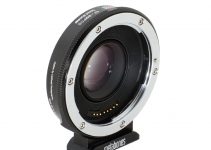Unless you are shooting with a camera that supports 10-bit 4:2:2 recording at the least, whether it’s internal or external, odds are you’ll frequently stumble upon color banding artifacts in your footage. This is especially true for most compact mirrorless cameras and DSLRs that are limited to 8-bit color depth recording regardless of the codec and resolution.
The easiest way to tackle this issue is by investing in a superior camera. If this is not an option, though, you can still try the following technique in After Effects showcased by Standard Film Team alongside the other tips and tricks covered below. Even though the results might not always be guaranteed, these are certainly worth a try.
First, import your footage in After Effects and change the Composition depth to 16-bit by clicking on the bits-per-channel button in the Project panel. Working in a higher bit depth provides greater precision for calculations and significantly reduces quantization artifacts, such as banding in gradients. If the color banding artifacts are still visible, however, you can also try the 32-bit (float) option.
Remove Color Banding (Adobe After Effects Tutorial) from Standard Film Team on Vimeo.
Even though the latter is considered as overkill in most cases, it could still help eventually. As a last resort, you can create an Adjustment Layer and drop the Noise filter on top. Switch off color noise and add 1% noise as a final retouch. This workflow should eliminate the nasty banding artifacts from your 8-bit footage entirely, or at least make them far less visible and annoying.
Other tips and tricks that can also help you in that regard are nailing a proper exposure and avoiding under-exposing your footage whenever it’s possible. Some noise reduction plugins might also help you along the way, such as the Neat Video and Red Giant’s Magic Bullet Denoiser. Increasing the ramp scatter parameter in the gradient ramp effect box could also be useful. Setting it around 70 should be a decent starting point, as you can continue with tweaking and experimenting from there.
If you have more time for post-production processing, you can also do some kind of chroma keying onto the surface that suffers from banding. This way the parts of the picture that contain details will not suffer from a plastic look, while the parts with gradients will be much smoother. Again, it’s not the ultimate solution, but you get the point.
What is your personal approach when it comes to dealing with color banding? Feel free to share in the comments below.
[source: Standard Film Team]
Disclaimer: As an Amazon Associate partner and participant in B&H and Adorama Affiliate programmes, we earn a small comission from each purchase made through the affiliate links listed above at no additional cost to you.
Claim your copy of DAVINCI RESOLVE - SIMPLIFIED COURSE with 50% off! Get Instant Access!




